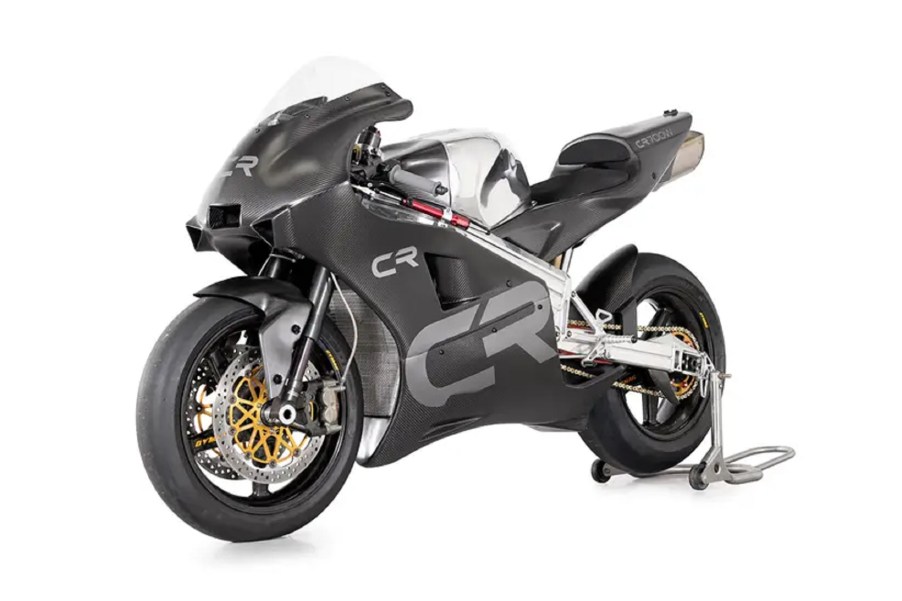
Crighton CR700W Rotary Track Motorcycle: A 220-Hp Ode to the Spinning Dorito
Flawed though it may be, the rotary engine still has its strengths and passionate devotees. But while most rotary fans are found in the four-wheeled world, some motorcycle riders pay homage to the high-revving Dorito, too. On the classic side, you have bikes like Jay Leno’s Suzuki RE5, for example. However, while Wankel-powered motorcycles are mostly things of the past, some engineers and designers have kept the engine design alive in the modern era. And the latest product of this passion is the new Crighton CR700W track bike.
Brian Crighton designed Norton’s race-winning rotary motorcycles—now he’s making his own

To understand the Crighton CR700W, you first must understand Brian Crighton. He’s a bit like a British Erik Buell, only instead of Harleys, he worked on Nortons. Specifically, Norton’s rotary racing motorcycles.
For some US enthusiasts, the Norton name conjures up images of 1970s Commando 750s and 850s. But that wasn’t its final chapter. Norton continued making bikes into the 1980s and 1990s, albeit on a significantly smaller scale. And in its final few years, it released a limited number of rotary-powered street bikes, such as the Classic and the Commander.
Interestingly, although the Wankel rotary engine has a reputation for being unreliable, Norton’s bikes were rather stout. The air-cooled 1987 Classic, for example, was actually more reliable than the RE5, Hagerty reports. And the rotary’s advantages—smooth operation, compact dimensions, and high specific output—made it, on paper, a logical choice for a race bike. At least, that’s what then-Norton engineer Brian Crighton thought, MCN explains.
In his off-hours, Crighton built a race bike around Norton’s 558cc air-cooled rotary engine. It placed third in its debut race, so the company decided to fund Crighton’s project. And by 1989, the team had an official sponsor and a bike: the Norton RCW588.
Despite stiff competition from the likes of the Honda RC30, the Norton rotary motorcycles were hugely successful. The RCW588 won two World Superbike Championships, the 1989 British Formula One Motorcycle and 750cc Championships, and the 1992 Isle of Man Senior TT. That 1992 win was the first for a British motorcycle in roughly 30 years.
Unfortunately, management disagreements made Crighton leave Norton in 1990. However, he’s dabbled in several rotary motorcycle projects since then. And since 2009, his company, Crighton Motorcycles, has been developing Wankel-powered bikes together with Rotron Power. The duo’s first project was the 2017 CRP700. Now, it’s time for the follow-up: the Crighton CR700W.
The Crighton CR700W: Norton’s former rotary racing guru makes a MotoGP-level track bike

| Spec | Crighton CR700W |
| Engine | 690cc twin-rotor rotary |
| Power | 220 hp |
| Torque | 105 lb-ft |
| Transmission | Six-speed manual with slipper clutch |
| Front suspension | Ohlins or Bitubo Superbike fully-adjustable inverted forks |
| Rear suspension | Ohlins or Bitubo long-stroke fully-adjustable mono-shock |
| Seat height | 31.9″ |
| Dry weight | 285 lbs |
If the Crighton CR700W’s engine seems small, that’s partially because rotaries are measured by their combustion chamber capacity. But it’s also because rotaries are compact. The CR700W’s all-aluminum engine is only 13” long and 9” wide. Plus, while it makes 220 hp, it only has three moving parts and weighs about 53 lbs. 95 lbs with its integrated six-speed transmission attached.
With that much power, the Crighton CR700W has roughly the same power-to-weight ratio as a modern MotoGP bike. And to keep the rotary from eating itself, it has silicon nitride ceramic apex seals that are supposedly wear-free. Also, its wear surfaces have Nikasil and molybdenum coatings. Furthermore, it has an internal cooling system with an integrated water pump.

However, the CR700W is technically also an air-cooled rotary motorcycle. That’s because its titanium-and-Inconel exhaust houses Crighton’s ‘exhaust ejector system.’ Developed for the RCW588, it uses exhaust gases to pull cooling air around the engine via the venturi effect. It’s the same principle that governs carburetors.
Given that its MotoGP-like performance, the Crighton CR700W uses its MotoGP-spec Brembo brakes. Also, its low weight is thanks to carbon-fiber bodywork, carbon-fiber wheels, and an aluminum frame. Speaking of, remember the earlier Erik Buell comparison? Well, taking a page from some of Buell’s bikes, the CR700W uses its frame spars as an oil reservoir. Moreover, it has an adjustable head-stock angle and swingarm pivot points.
How can you get one of these Wankel track bikes?

As noted earlier, the Crighton CR700W is a track motorcycle, so it’s not road-legal. But that might make importing one to the US easier, paperwork-wise.
However, getting your hands on one of these rotary track motorcycles won’t be easy—or cheap. Crighton is only making 25. To clarify, we mean hand-building them himself. Prices start at roughly $115,000.
But if you can’t get one, know that some of Crighton’s earlier bikes are easier to find and easier on the wallet. Norton made 145 F1s, and they often go for $30K-$45K, Mecum says. Though other rotary Nortons are even cheaper. Still, just knowing that another company besides Mazda is championing the rotary will likely be enough for Wankel fans.
Follow more updates from MotorBiscuit on our Facebook page.


